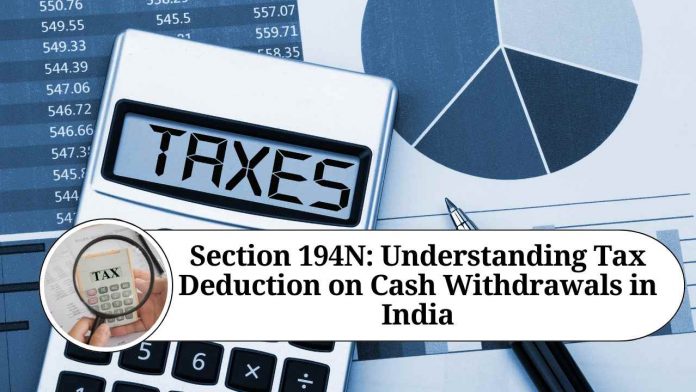Introduction:
The Indian government has implemented various measures to promote digital transactions and curb the circulation of black money. One such measure is the introduction of Section 194N of the Income Tax Act, which imposes a tax deduction at source (TDS) on cash withdrawals exceeding specified limits. This blog aims to demystify Section 194N and provide a comprehensive understanding of its provisions, applicability, and implications.
Understanding Section 194N:
Section 194N was introduced in the Union Budget of 2019 as a measure to discourage the use of cash for large-value transactions and promote a cashless economy. It mandates that banks and cooperative societies deduct tax at the rate of 2% on cash withdrawals made by individuals and Hindu Undivided Families (HUFs) exceeding certain limits in a financial year.
Applicability and Thresholds:
Section 194N is applicable to cash withdrawals made by individuals and HUFs. However, it does not apply to withdrawals made by certain specified entities, such as the government, banks, cooperative societies engaged in banking business, and certain other exempted entities.
The thresholds for TDS under Section 194N are as follows:
- If the recipient does not file an income tax return for the three preceding assessment years, and the aggregate amount of cash withdrawals in a financial year exceeds Rs. 20 lakh, then the TDS rate is 2%.
- If the recipient files an income tax return for the three preceding assessment years and the aggregate amount of cash withdrawals in a financial year exceeds Rs. 1 crore, then the TDS rate is 2%.
It’s important to note that the thresholds are calculated on a cumulative basis, taking into account withdrawals from all accounts of the recipient held with a particular bank or cooperative society.
Implications and Compliance:
The primary implication of Section 194N is the TDS deduction on cash withdrawals exceeding the specified thresholds. The tax deducted by the bank or cooperative society is deposited with the government and reflected in the individual’s or HUF’s Form 26AS (Annual Statement). This TDS amount can be claimed as a credit while filing the income tax return.
To ensure compliance with Section 194N, individuals and HUFs should maintain proper records of cash withdrawals and review their Form 26AS to verify the TDS amount deposited by the bank or cooperative society. It is crucial to report this TDS amount accurately in the income tax return to avoid any discrepancies or issues with the tax authorities.
Conclusion:
Section 194N of the Income Tax Act serves as a mechanism to discourage the use of cash for large-value transactions and promote digital transactions. By imposing a tax deduction at source on cash withdrawals exceeding specified limits, the government aims to track and regulate cash transactions, promote transparency, and curb the circulation of unaccounted money.
Individuals and HUFs should be aware of the provisions and thresholds outlined in Section 194N to ensure compliance with tax regulations. It is advisable to consult a tax professional or refer to the official guidelines issued by the Income Tax Department for specific queries and detailed information on Section 194N and its implications.
Embracing digital transactions not only aligns with the government’s vision of a cashless economy but also offers several benefits in terms of convenience, security, and transparency. So, let’s adapt to the changing landscape of financial transactions and contribute to the growth and development of a digitally empowered India.
Other Related Blogs: Section 144B Income Tax Act
Frequently Asked Questions (FAQs)
Q.What is Section 194N of the Income Tax Act?
Section 194N is a provision in the Income Tax Act that requires banks and cooperative societies to deduct tax at source (TDS) on cash withdrawals exceeding specified limits made by individuals and HUFs.
Q.Who is liable to deduct TDS under Section 194N?
Banks and cooperative societies are responsible for deducting TDS under Section 194N when individuals and HUFs make cash withdrawals exceeding the prescribed thresholds.
Q.What are the thresholds for TDS deduction under Section 194N?
The TDS rate of 2% applies when the aggregate cash withdrawals in a financial year exceed Rs. 20 lakh for non-filers of income tax returns and Rs. 1 crore for individuals who have filed their income tax returns for the past three assessment years.
Q.Is Section 194N applicable to all cash withdrawals?
No, Section 194N is not applicable to all cash withdrawals. It applies only to cash withdrawals made by individuals and HUFs, and certain specified entities are exempted from this provision.
Q.How is the TDS amount calculated under Section 194N?
The TDS amount is calculated at a rate of 2% on the cash withdrawal amount exceeding the prescribed thresholds.
Q.Can I claim a credit for the TDS amount deducted under Section 194N?
Yes, you can claim a credit for the TDS amount deducted under Section 194N while filing your income tax return. The TDS amount will be reflected in your Form 26AS.
Q.Are there any exemptions to Section 194N?
Yes, certain entities are exempted from the provisions of Section 194N. This includes the government, banks, cooperative societies engaged in banking business, and certain other specified entities.
Q.How can I ensure compliance with Section 194N?
To comply with Section 194N, it is important to maintain proper records of cash withdrawals and review your Form 26AS to verify the TDS amount deposited by the bank or cooperative society. Report this TDS amount accurately in your income tax return.
Q.What are the penalties for non-compliance with Section 194N?
Non-compliance with the provisions of Section 194N may attract penalties and interest as per the Income Tax Act. It is important to adhere to the requirements to avoid any legal consequences.
Q.Is there any difference in the TDS rates for resident and non-resident individuals under Section 194N?
No, Section 194N does not differentiate between resident and non-resident individuals. The TDS rates and thresholds remain the same for both categories.




















